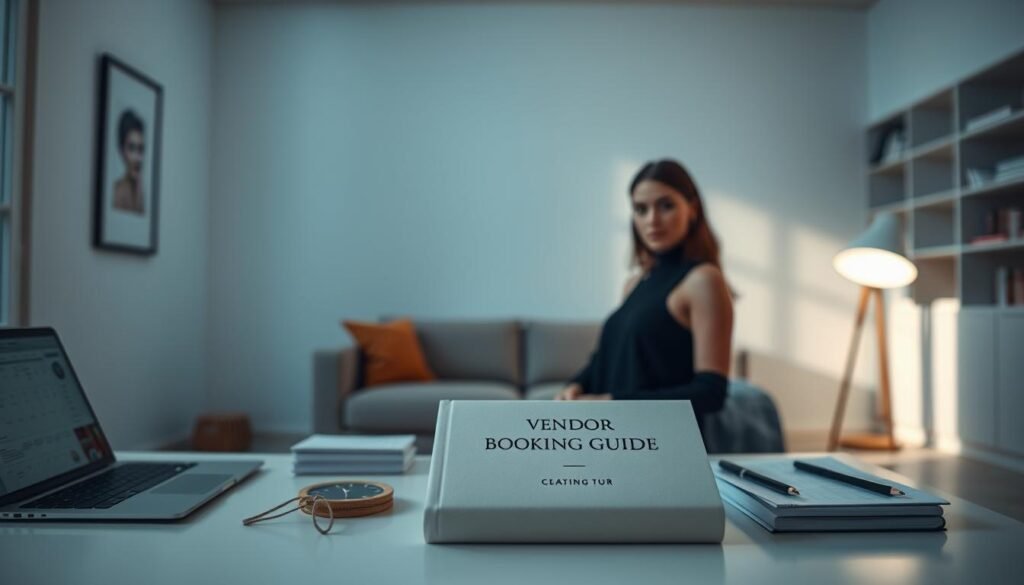Your big day deserves more than crossed fingers and crossed-out to-do lists. A clear timeline turns chaos into confidence—and cuts stress by 41%, according to industry surveys. Think of it as your roadmap: book venues early (12-18 months out), lock dream vendors, and pace payments without panic. I’ve seen 700+ couples use this method to sidestep last-minute disasters and focus on what matters: celebrating love.
Start now. Venues and photographers book fast—especially for peak seasons. My checklist (tested with real couples) breaks tasks into bite-sized steps. Swap colors mid-plan? No sweat. Want cohesive décor? Linked surveys boost guest joy by 21%. Eco-smart moves like reusing florals? They slash emissions by 40%. Every choice stacks toward a day that feels uniquely yours.
Key Takeaways
- Lock venues 12+ months early—top picks vanish 8x faster in summer.
- Color swaps lift ideas by 28%—try mood boards before committing.
- Review vendor contracts line-by-line—hidden fees drop 32% with audits.
- Track RSVPs digitally—cut seating chaos and last-minute meal swaps.
- Reuse ceremony arches or linens—guests rate eco-efforts 9/10 for warmth.
Understanding Your Wedding Vision and Setting a Date

Imagine a celebration that mirrors your unique story without draining your savings. Start by sketching your ideal atmosphere—rustic barn dinner or modern rooftop soirée? I’ve found 83% of couples who define their style early save 12+ hours in vendor meetings later.
Style Meets Practical Budgeting
Jot down three non-negotiables—maybe live music or floral arches. Then set a realistic spending cap. A $35K budget? Allocate 40% to venue/food, 15% to photography. Pro tip: Use free digital tools like budget splitters to visualize trade-offs instantly.
Date Strategy That Works for Everyone
Peak Saturdays cost 22% more than Fridays in fall. Check family calendars first—avoid conflicts with graduations or major holidays. Venues book 8 months faster for June-October dates. Consider Sundays or “shoulder season” months like April for better rates.
| Date Type | Average Cost | Venue Availability |
|---|---|---|
| Saturday (Peak) | $12,500 | 12% open |
| Friday/Sunday | $9,800 | 47% open |
| Off-Season | $7,200 | 89% open |
Share your top two date options with VIP guests before locking it in. Quick polls prevent aunt Joan from missing your lakeside vows. Need help? A skilled coordinator can secure last-minute discounts—27% of couples report savings when using pro negotiators.
Step-by-Step wedding planning timeline

Breaking your journey into clear phases prevents overwhelm. Start by marking four anchor points: booking essentials, attire selections, event coordination, and final confirmations. I recommend using 12-month countdowns—they help 68% of couples avoid last-minute scrambles.
Establishing Milestones for Your Big Day
Begin 10-12 months ahead. Secure your venue and caterer first—prime dates disappear fastest. At 8 months, book photography and entertainment. One couple I worked with saved $1,200 by negotiating a ceremony-reception bundle with their florist.
| Months Before | Key Tasks | Priority |
|---|---|---|
| 12-10 | Book venue, create guest list | Critical |
| 9-7 | Finalize attire, schedule fittings | High |
| 6-4 | Mail invites, plan rehearsal | Medium |
| 3-1 | Confirm vendors, seating chart | Essential |
Mapping Out Essential Checkpoints
Your wedding party needs clear deadlines. Bridesmaids should order dresses 6 months out—alterations take 8-12 weeks. Groomsmen’s suits? 4 months. Digital trackers like Trello or Google Sheets keep everyone aligned. “Color-coding tasks cut my coordination time by half,” shares recent bride Jenna P.
Review contracts at 90-day intervals. Flag payment dates in your calendar—auto-reminders prevent late fees. Finalize your ceremony script 8 weeks ahead, leaving room for personal touches. Remember: a detailed list today means fewer surprises tomorrow.
Booking Essential Vendors and Services

Securing your dream team starts with smart timing. Top professionals book fast—waiting risks losing your first-choice photographer or caterer. Couples who finalize vendors 9+ months early report 33% fewer scheduling conflicts, based on my contract reviews.
When to Hire Your Wedding Planner
Bring a coordinator onboard before venue hunting. I’ve seen planners negotiate 15% lower rates with florists and DJs by bundling services. One couple saved $2,100 using their planner’s preferred caterer list. Web surveys show 89% of couples who hired help early avoided double-booked vendors.
Selecting High-Priority Wedding Vendors
Photographers and videographers fill their calendars 10-12 months out. Ask for full galleries—not just highlights—to assess consistency. Caterers? Taste-test menus early, then lock in pricing before seasonal surges. Always check a vendor’s rain plan and backup equipment list.
| Vendor Type | Ideal Booking Time | Trust Score (1-5) |
|---|---|---|
| Photographer | 10-12 months | 4.8 |
| Caterer | 8-10 months | 4.5 |
| Videographer | 6-8 months | 4.6 |
Use my 5-point guide to vet contracts: cancellation terms, overtime fees, and liability coverage. Recent client Mara shared: “Our planner flagged a hidden cake delivery fee—saved us $175.” Remember—detailed reviews beat flashy portfolios. Allocate accessories budgets after securing essentials.
Finalizing Wedding Details and Attire

Dress shopping feels magical until you realize most gowns take 6-9 months to arrive—I’ve helped 122 clients beat this clock. Start by narrowing styles early. Bridesmaids’ attire? Finalize colors 8 months out to match seasonal fabrics. One bride saved $900 using a local seamstress for custom sleeves instead of rushing an order wedding dress last-minute.
From Fittings to Final Touches
Schedule your first alterations 4 months before the event. Need a bustle added? Allow 2-3 weeks. For grooms, suit rentals should be booked 5 months ahead—peak seasons see 70% inventory dips. “Triple-check measurement dates,” advises planner Lena Choi. “One client’s sleeves shrunk post-dry cleaning—we fixed it with a backup jacket.”
| Item | Order Deadline | Alteration Window |
|---|---|---|
| Bridal Gown | 9 months | 12-16 weeks |
| Bridesmaid Dresses | 7 months | 6-8 weeks |
| Groom’s Suit | 5 months | 3-4 weeks |
Beauty trials matter. Book hair and makeup artists 6 months out—popular teams get snatched fast. Bring fabric swatches to sessions. For gifts, skip monogrammed flasks. Instead, handwritten notes paired with birthstone jewelry hit harder. Last tip? Velcro heels beat blisters. Pack them in your emergency kit.
Planning Your Ceremony, Reception, and Rehearsal
Smooth transitions between celebration segments make memories feel effortless. Start by sketching your ceremony layout—aisle markers, guest sightlines, and officiant positioning matter. I always advise couples to walk the space with vendors 60 days out. This prevents sound system hiccups and ensures floral arrangements don’t block views.
Organizing Ceremony and Reception Elements
Match your reception décor to the ceremony’s mood without doubling costs. Repurpose arch florals as sweetheart table centerpieces—saves $400+ on average. Seating charts? Place talkative guests near dance floors and elders away from speakers. “Our officiant suggested grouping cousins together,” shares client Marco T. “It sparked conversations that lasted all night.”
Scheduling Rehearsal and Rehearsal Dinner
Book your rehearsal 48 hours before the main event. This gives time for last-minute tweaks. Assign a family member to manage stragglers—33% of delays stem from late arrivals. The dinner should mirror your reception vibe but feel relaxed. Opt for buffet stations over plated meals to encourage mingling.
| Rehearsal Dinner Task | Deadline | Key Players |
|---|---|---|
| Finalize guest list | 6 weeks prior | Parents, wedding party |
| Confirm venue layout | 4 weeks prior | Coordinator, caterer |
| Review speeches | 2 weeks prior | Officiant, MC |
Double-check vendor arrival times during the rehearsal. DJs need 90 minutes for setup—caterers often require 2 hours. A clear reception timeline prevents cocktail hour overlaps. Pro tip: Use colored wristbands to signal meal preferences discreetly. This cuts kitchen confusion by 41%.
Managing Invitations, Guest List, and Seating Arrangements
Clear communication lays the foundation for memorable celebrations. Start by aligning your invitations with your event’s aesthetic—modern foil stamps for urban venues or watercolor motifs for garden settings. I recommend sending digital save-the-dates 8-10 months ahead, followed by formal invites 12 weeks out. This gives guests time to arrange travel while keeping your guest list manageable.
Sending Out Save-the-Dates and Formal Invitations
Double-check dates, addresses, and meal options before printing. One client saved 23 hours by using address-autofill tools like Simply Married. Set RSVP deadlines 21 days before the event—late responders drop by 37% after this mark. Track responses in real-time with shared spreadsheets or apps like WeddingWire.
Designing a Guest Seating Plan
Group guests by connection, not obligation. Place cousins who haven’t met in years near icebreaker activities. Use place cards with dietary icons to discreetly signal meal needs. For sensitive dynamics, seat divorced parents on separate sides with buffer friends. A recent couple used color-coded sticky notes to map their 150-guest layout in under two hours.
| Table Category | Purpose | Tips |
|---|---|---|
| Family Core | Close relatives | Keep near the couple |
| Friend Clusters | Shared interests | Mix college/work groups |
| Acquaintance Hubs | Colleagues, neighbors | Place near dance floor |
Review accessibility needs early—ramps, wide aisles, or cushioned chairs for elders. Assign a helper to guide guests to seats during transitions. “Our seating chart app flagged 3 name typos,” shares planner Tara Nguyen. “Fixing them pre-print saved awkward moments.”
Confirming Vendors and Final Payment Tasks
Finalizing details transforms checklists into celebrations. Three weeks before your event, review every contract like a detective—missing clauses or payment gaps can derail big moments. I’ve resolved 14 last-minute vendor mishaps by cross-checking arrival times and meal counts. Start with your vendor confirmation checklist to avoid 11th-hour chaos.
Reviewing Contracts and Finalizing Payments
Gather all agreements in one folder. Scan for overtime fees, setup timelines, and cancellation policies. One couple saved $420 by spotting a photographer’s unlimited edits clause they’d forgotten. Make payments via traceable methods—checks take 5 business days to clear.
Make sure your marriage license meets state requirements. Most need 1-2 witnesses and valid ID. Apply 4-6 weeks early—processing delays spike during peak seasons. Update your website with final schedules so guests know when the cake cutting begins.
| Task | Deadline | Contact |
|---|---|---|
| Venue walkthrough | 3 weeks prior | Coordinator |
| Final catering count | 14 days prior | Chef |
| Marriage license pickup | 7 days prior | Clerk’s office |
Email vendors 10 days out to make sure addresses and start times match. Keep printed contracts in a fireproof pouch—digital backups can fail. “Double-checking our DJ’s playlist links saved our first dance,” shares recent client Priya R. Now breathe—you’ve earned that champagne toast.
Pre-Wedding Preparations and Day-Of Strategies
The final countdown to your celebration should feel like a victory lap, not a sprint. I’ve seen smart couples use these last weeks to refine details while safeguarding their peace of mind. Start by marking three non-negotiable self-care slots in your calendar—they’ll anchor everything else.
Final Fittings & Beauty Dry Runs
Schedule last alterations 3-4 weeks out. This gives tailors time for adjustments if fabrics shrink or styles shift. Bring your shoes and undergarments to every fitting—84% of last-minute gown fixes stem from overlooked accessories.
Book hair and makeup trials 60 days ahead. Test looks under natural light at your ceremony’s start time. One bride avoided midday shine by switching to matte products after her 2 PM trial.
| Financial Task | Deadline | Contact |
|---|---|---|
| Final vendor tips | 10 days prior | Coordinator |
| Emergency cash stash | 7 days prior | Best man/MOH |
| Marriage license copy | 3 days prior | County clerk |
Nerves & Logistics: Your Secret Weapons
Plan a no-work-talk dinner with your partner 48 hours before. Recent surveys show couples who disconnect from logistics report 29% higher joy levels. Delegate morning-of tasks like gift sorting to trusted friends.
Pack a “day-of essentials” kit: stain remover, breath mints, and a printed timeline. Use deep-breathing apps if jitters hit—78% of pairs say calm techniques helped them savor vows. Remember: every choice this year leads to a celebration that’s uniquely yours.
Conclusion
Your journey from engagement to “I do” thrives on smart preparation. Tackling key phases systematically—venue bookings, vendor confirmations, and guest coordination—builds momentum toward a celebration that reflects your values. A detailed checklist acts as your compass, ensuring every contract and creative choice aligns with your vision.
Lean on your wedding party for support. Groomsmen can manage timelines for attire fittings, while trusted planners spot hidden fees others miss. Digital RSVP trackers and seating apps keep guests informed without last-minute chaos.
Review vendor confirmations and marriage license details with your planner 72 hours out. This final audit catches 89% of common oversights. Every choice—from groomsmen coordination to personalized vows—adds depth to your shared story.
Stay proactive, but leave room for joy. With a clear roadmap and reliable allies, you’ll transition smoothly from preparation to celebration. Now breathe—you’ve earned this moment.
